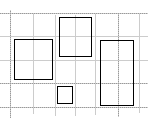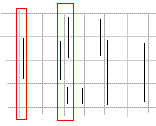|
|
思路: 一开始想到用线段树来做,但是发现坐标范围异常的大,放一个都勉勉强强,更不用说几个了! 想了一下,发现有一个至关重要的条件“不存在覆盖的情况”。 那就没必要用线段树了,因为压根就没必要解决覆盖问题。 可以用一种取巧的方法解决这题。  对于每个矩形,首先把它 y 方向的两条边抽取出来。 对于所有矩形的 y 方向的边,先按照 x 排序,然后按照顶端的 y 坐标排序。  然后对于位于同一 x 坐标的边,找出所有首尾相接或者有交集的边。 那么这些边对应的矩形必定要排除。 对于 x 方向的边,作同样的处理。 排除完之后,剩下的矩形就是可以答案了。 代码 500 多ms。。
 #include <stdio.h> #include <stdio.h>
 #include <stdlib.h> #include <stdlib.h>

 #define MAX_N 25032 #define MAX_N 25032

  struct node struct node  { {
 int barn, start, end, idx; int barn, start, end, idx;
 }; };
 struct node vert[MAX_N * 2], hori[MAX_N * 2]; struct node vert[MAX_N * 2], hori[MAX_N * 2];
 char cannot[MAX_N]; char cannot[MAX_N];
 int N, ans; int N, ans;

 __inline void add_node(struct node *t, int barn, int start, int end, int idx) __inline void add_node(struct node *t, int barn, int start, int end, int idx)
   { {
 t->barn = barn; t->barn = barn;
 t->start = start; t->start = start;
 t->end = end; t->end = end;
 t->idx = idx; t->idx = idx;
 } }

 int cmp_node(const void *a, const void *b) int cmp_node(const void *a, const void *b)
   { {
 struct node *p, *q; struct node *p, *q;
 p = (struct node *)a; p = (struct node *)a;
 q = (struct node *)b; q = (struct node *)b;
 if (p->idx != q->idx) if (p->idx != q->idx)
 return p->idx - q->idx; return p->idx - q->idx;
 return p->start - q->start; return p->start - q->start;
 } }

 __inline void disable_barn(int barn) __inline void disable_barn(int barn)
   { {
  if (!cannot[barn]) if (!cannot[barn])  { {
 cannot[barn] = 1; cannot[barn] = 1;
 ans--; ans--;
 } }
 } }

 __inline void calc(struct node *arr, int len) __inline void calc(struct node *arr, int len)
   { {
 int i, idx, end, cnt, first; int i, idx, end, cnt, first;

 i = 0; i = 0;
  while (i < len) while (i < len)  { {
 idx = arr[i].idx; idx = arr[i].idx;
 end = arr[i].end; end = arr[i].end;
 first = i; first = i;
 cnt = 0; cnt = 0;
 i++; i++;
  while (i < len && arr[i].idx == idx && arr[i].start <= end) while (i < len && arr[i].idx == idx && arr[i].start <= end)  { {
 if (arr[i].end > end) if (arr[i].end > end)
 end = arr[i].end; end = arr[i].end;
 disable_barn(arr[i].barn); disable_barn(arr[i].barn);
 cnt++; cnt++;
 i++; i++;
 } }
 if (cnt) if (cnt)
 disable_barn(arr[first].barn); disable_barn(arr[first].barn);
 } }
 } }

 int main() int main()
   { {
 int i, top, left, bottom, right; int i, top, left, bottom, right;

 freopen("e:\\test\\in.txt", "r", stdin); freopen("e:\\test\\in.txt", "r", stdin);

 scanf("%d", &N); scanf("%d", &N);
 ans = N; ans = N;
  for (i = 0; i < N; i++) for (i = 0; i < N; i++)  { {
 scanf("%d%d%d%d", &left, &bottom, &right, &top); scanf("%d%d%d%d", &left, &bottom, &right, &top);
 add_node(&vert[i * 2], i, bottom, top, left); add_node(&vert[i * 2], i, bottom, top, left);
 add_node(&vert[i * 2 + 1], i, bottom, top, right); add_node(&vert[i * 2 + 1], i, bottom, top, right);
 add_node(&hori[i * 2], i, left, right, top); add_node(&hori[i * 2], i, left, right, top);
 add_node(&hori[i * 2 + 1], i, left, right, bottom); add_node(&hori[i * 2 + 1], i, left, right, bottom);
 } }
 qsort(vert, N * 2, sizeof(vert[0]), cmp_node); qsort(vert, N * 2, sizeof(vert[0]), cmp_node);
 qsort(hori, N * 2, sizeof(hori[0]), cmp_node); qsort(hori, N * 2, sizeof(hori[0]), cmp_node);
 calc(vert, N * 2); calc(vert, N * 2);
 calc(hori, N * 2); calc(hori, N * 2);
 printf("%d\n", ans); printf("%d\n", ans);

 return 0; return 0;
 } }


|